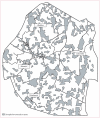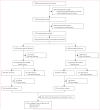Swaziland HIV Incidence Measurement Survey (SHIMS): a prospective national cohort study
- PMID: 27863998
- PMCID: PMC5291824
- DOI: 10.1016/S2352-3018(16)30190-4
Swaziland HIV Incidence Measurement Survey (SHIMS): a prospective national cohort study
Abstract
Background: Swaziland has the highest national HIV prevalence worldwide. The Swaziland HIV Incidence Measurement Survey (SHIMS) provides the first national HIV incidence estimate based on prospectively observed HIV seroconversions.
Methods: A two-stage survey sampling design was used to select a nationally representative sample of men and women aged 18-49 years from 14 891 households in 575 enumeration areas in Swaziland, who underwent household-based counselling and rapid HIV testing during 2011. All individuals aged 18-49 years who resided or had slept in the household the night before and were willing to undergo home-based HIV testing, answer demographic and behavioural questions in English or siSwati, and provide written informed consent were eligible for the study. We performed rapid HIV testing and assessed sociodemographic and behavioural characteristics with use of a questionnaire at baseline and, for HIV-seronegative individuals, 6 months later. We calculated HIV incidence with Poisson regression modelling as events per person-years × 100, and we assessed covariables as predictors with Cox proportional hazards modelling. Survey weighting was applied and all models used survey sampling methods.
Findings: Between Dec 10, 2010, and June 25, 2011, 11 897 HIV-seronegative adults were enrolled in SHIMS and 11 232 (94%) were re-tested. Of these, 145 HIV seroconversions were observed, resulting in a weighted HIV incidence of 2·4% (95% CI 2·1-2·8). Incidence was nearly twice as high in women (3·1%; 95% CI 2·6-3·7) as in men (1·7%; 1·3-2·1, p<0·0001). Among men, partner's HIV-positive status (adjusted hazard ratio [aHR] 2·67, 1·06-6·82, p=0·040) or unknown serostatus (aHR 4·64, 2·32-9·27, p<0·0001) in the past 6 months predicted HIV seroconversion. Among women, significant predictors included not being married (aHR 2·90, 1·44-5·84, p=0·0030), having a spouse who lives elsewhere (aHR 2·66, 1·29-5·45, p=0·0078), and having a partner in the past 6 months with unknown HIV status (aHR 2·87, 1·44-5·84, p=0·0030).
Interpretation: Swaziland has the highest national HIV incidence in the world. In high-prevalence countries, population-based incidence measures and programmes that further expand HIV testing and support disclosure of HIV status are needed.
Funding: President's Emergency Plan for AIDS Relief (PEPFAR) by the Centers for Disease Control and Prevention.
Copyright © 2017 Elsevier Ltd. All rights reserved.
Figures
Comment in
-
Assessing progress with HIV incidence in national cohorts.Lancet HIV. 2017 Feb;4(2):e56-e58. doi: 10.1016/S2352-3018(16)30187-4. Epub 2016 Nov 16. Lancet HIV. 2017. PMID: 27863999 No abstract available.
References
-
- Central Statistical Office, Swaziland, and Macro International Swaziland demographic and health survey 2006–07. Chapter 14: HIV prevalence and associated factors. http://www.measuredhs.com/publications/publication-fr202-dhs-final-repor... (accessed Sept 23, 2015)
-
- Partnership Framework on HIV and AIDS, 2009–2013. The Government of the Kingdom of Swaziland and the Government of the United States of America. 2009 http://www.pepfar.gov/documents/organization/124969.pdf (accessed Sept 23, 2015)
-
- UNAIDS Practical guidelines for intensifying HIV prevention: towards universal access: UNAIDS. 2007 http://data.unaids.org/pub/Manual/2007/20070306_Prevention_Guidelines_To... (accessed Aug 24, 2014)
MeSH terms
Grants and funding
LinkOut - more resources
Full Text Sources
Other Literature Sources
Medical
Research Materials
Miscellaneous




